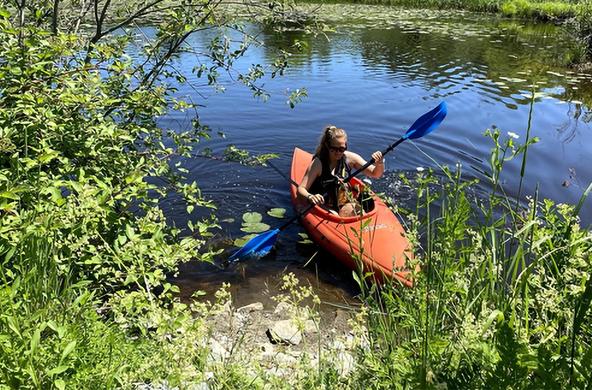Currently there are about 75,000,000 pigs in the United States. They generate a lot of poop, for which disposal is an ongoing problem in need of good solutions.
North Carolina is home to about 12% of the nation’s hogs, and a lot of solid and liquid waste (urine) is collected in open ponds or lagoons, in which the urea is converted to nitrate that can be sprayed on nearby farm fields as fertilizer. Some of the nitrate in lagoons is also converted to nitrogen gas by microbes and returned to the atmosphere.
Depending on their condition, lagoons are also a source of ammonia, hydrogen sulfide, and methane gases that leak to the atmosphere. These gases account for the odor of hog lagoons, which are currently under lawsuits for their impact on human health and property values. Methane is of particular concern, because methane is an important “greenhouse gas” in Earth’s atmosphere, leading to global warming of our planet. The methane from hog lagoons, known as biogas, is an identical molecule to the methane that we remove from the Earth’s crust, where it is known as natural gas and used for heat, electricity, and other demands for fossil fuels. Methane from hog lagoons is identical to methane captured from landfills.
Currently, nearly all the methane from hog lagoons is vented to the atmosphere. If we could capture the methane from hog lagoons, we could see the dual benefits of reducing the potential for climate change and increasing the revenue derived from raising pigs. Some of the structures needed to capture the methane could simultaneously capture ammonia and hydrogen sulfide, reducing this public nuisance.
Let’s put some numbers on what might be possible. A few studies have estimated that about 2000 cubic feet of methane per year are generated when the waste of a single animal that is confined in a lagoon. North Carolina hosts about 10,000,000 hogs, so they would produce 20 x 109 ft3/year. For North Carolina, recent consumption of natural gas each year amounts to about 500 x 109 ft3/yr, so, roughly 4% of the demand for natural gas in North Carolina could be met by biogas. North Carolina has a lot of hogs; a rough calculation for the entire United States indicates that hog waste could supply about 0.5% of our natural gas consumption.
It would be more difficult to capture methane produced from the cattle manure, since so much of it is deposited in pastures and rangelands. Still, the manure from dairy operations and local feedlots might be managed to capture methane. Overall, the disposal of animal wastes contributes about 7.5% of the human contributions of methane to the atmosphere, worldwide. Cattle, of course, are responsible for another 30% that stems from their digestional belches.
The methane from hog and cattle wastes is currently allowed to leak into the atmosphere. As a way to reduce these emissions and provide supplemental income to meat producers, methane captured as biogas can help contribute to our solutions to climate change.
References
Energy Information Agency. 2016. North Carolina State Profile and Energy Estimates https://www.eia.gov/state/data.php?sid=NC
Lory, J.A., R.E. Massey, and J.M. Zulovich. 2010. An evaluation of the USEPA calculations of greenhouse gas emissions from anaerobic lagoons. Journal of Environmental Quality 39: 776-783.
Mangino, J., D. Bartram, and A. Brazy. 2001. Development of a methane conversion factor to estimate emissions from animal waste lagoons. https://www3.epa.gov/ttnchie1/conference/ei11/ammonia/mangino.pdf
Schlesinger, W.H. and E.S. Bernhardt. 2013. Biogeochemistry: An analysis of global change. Academic Press/Elsevier. San Diego.
Translational Ecology. 2017. Ammonia. https://blogs.nicholas.duke.edu/citizenscientist/ammonia/






